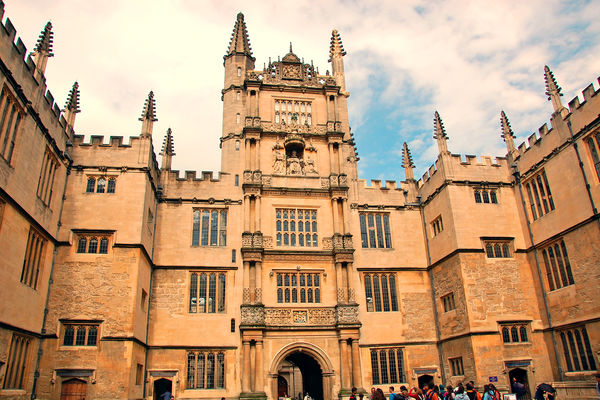Visiting Europe’s Great Libraries
By Rick Steves

For travelers with an interest in the evolution of Western culture, a stop at one of Europe's grand libraries is an unforgettable experience. Many of them offer the chance to connect with books and documents that changed the course of history — while basking in impressive, ornate interiors that reflect the tremendous importance of books in earlier centuries.
One of the oldest libraries in Europe is the Bodleian Library at England's Oxford University. Opened in 1602, it incorporates the older Duke Humfrey's Library from the 15th century. In those days, libraries were placed above classrooms for maximum sunlight and minimum moisture. Books were considered so precious that many were actually chained to a desk. Today this historic library is a world of creaky old shelves of books dating to the Middle Ages, stacked neatly under a beautifully painted wooden ceiling. The space is so atmospheric, it served as Hogwarts' library in the Harry Potter films. (Duke Humfrey's Library is viewable only on a popular guided tour — book in advance.)
The Weston Library, a more modern wing of the Bodleian, welcomes visitors to enjoy a gallery showcasing a changing selection of its most precious items, including a Shakespeare First Folio (18 plays from 1623), an original score of Handel's Messiah (written in 1741), and several original versions of the 1215 Magna Carta — the first legal document to set limits on a ruler's power and the basis of many modern constitutions.
Many of Europe's oldest universities have equally fascinating libraries, such as the architecturally glorious Wren Library at Cambridge's Trinity College, the grand Baroque King João's Library at Coimbra Univeristy in central Portugal, and the library at Dublin's Trinity College, which holds the magnificent Book of Kells.
Though it lacks the Bodleian's Old World mystique, the Treasures gallery of the British Library in London is packed with even more intriguing artifacts. The sheer size of the massive collection is impressive enough, with nearly 300 miles of shelving holding over 12 million books. Out front in the courtyard, a statue of Isaac Newton, shown measuring the immensity of the universe, symbolizes the library's purpose: to gather all knowledge and promote humanity's endless search for truth. But the Treasures room is the reason to visit, with its original ancient maps, illuminated Gospels on parchment, the Gutenberg Bible, precious musical manuscripts, Lewis Carroll's Alice's Adventures in Wonderland, and handwritten Beatles lyrics. The only known manuscript of the epic saga Beowulf (AD 1000) is here, as is Geoffrey Chaucer's bawdy Canterbury Tales (c. 1410). Display cases feature trailblazing documents by early scientists such as Galileo and Isaac Newton. Pages from Leonardo da Vinci's notebook show his powerful curiosity and his famous backwards handwriting. Depending on what's on display during your visit, you may see letters by Henry VIII, Queen Elizabeth I, Darwin, Freud, or Gandhi.
In the centuries after the fall of the Roman Empire, and into the Middle Ages, it was primarily monks who preserved and painstakingly copied ancient manuscripts, and who kept the flame of literacy alive in Europe. And today, many of Europe's finest old libraries are still housed in monasteries.
The library at Strahov Monastery in Prague is filled with books from the 10th through 17th centuries, shelved under elaborately frescoed ceilings that celebrate philosophy, theology, and the quest for knowledge. As the Age of Enlightenment took hold, the Church struggled to maintain its social and political power. Books that contained challenging ideas — by thinkers like Nicolaus Copernicus, Jan Hus, and Jean-Jacques Rousseau — were placed in a gilded, locked case. Only the abbot had the key, and you needed his blessing to open it. Pondering these treasured volumes from our Information Age perspective, I'm reminded of the importance of free access to information.
Not far to the south is the massive Melk Abbey, gleaming on its hilltop over the Wachau Valley, just up the Danube from Vienna. My favorite part of a visit here is its elegant library — another remainder from when monasteries served as crucial storehouses of knowledge. Many of the collection's oldest books were written and transcribed in this space, before the 11th-century Benedictine abbey was devastated by fire. It was rebuilt in the 18th century in sumptuous Baroque splendor, with inlaid bookshelves, matching bindings, and a frescoed ceiling. The extravagant investment that went into the elaborate decor makes clear the monks' reverence for knowledge. Highlights include two precious globes (one terrestrial, one celestial — with the night sky inside out) that date from 1688 and were painstakingly researched and crafted. Students and researchers still use the many manuscripts housed in the library's temperature-controlled rooms.
A little farther down the Danube, in Vienna, is another postcard-perfect Baroque library: the Austrian National Library's State Hall. Here glorious paintings celebrate high culture and the library's patron, Emperor Charles VI. This former imperial library, with a statue of Charles VI in the center, makes it clear that knowledge of the world was for the elite — and with that knowledge, the elite had power. More than 200,000 old books line the walls, but patrons go elsewhere to read them; the hall is just for show these days. Glass cases lining the nave-like main aisle display literary treasures (all well described in English).
Throughout Europe, wonderful old libraries are inspiring reminders of humanity's relatively recent, but ardent quest to compile written knowledge in order to share it with future generations.

